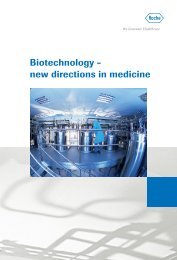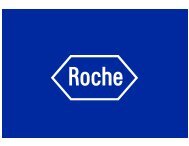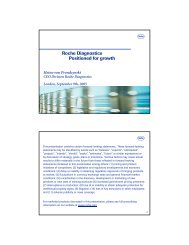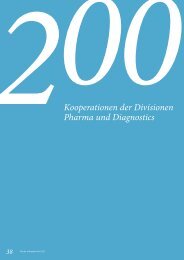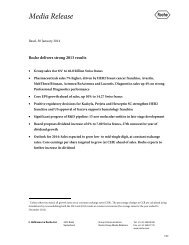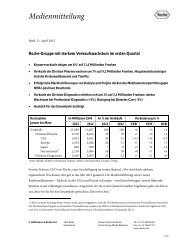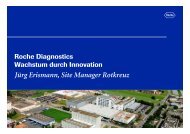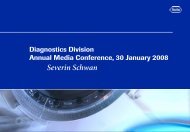Microsoft PowerPoint - Roche IR Event EULAR Final.ppt
Microsoft PowerPoint - Roche IR Event EULAR Final.ppt
Microsoft PowerPoint - Roche IR Event EULAR Final.ppt
Create successful ePaper yourself
Turn your PDF publications into a flip-book with our unique Google optimized e-Paper software.
<strong>Roche</strong> Analyst Meeting<br />
<strong>EULAR</strong> 2007<br />
Barcelona, Spain<br />
Friday, June 15, 2007<br />
2
Forward-looking statements<br />
This presentation contains certain forward-looking statements. These forward-looking statements may be<br />
identified by words such as ‘believes’, ‘expects’, ‘anticipates’, ‘projects’, ‘intends’, ‘should’, ‘seeks’, ‘estimates’,<br />
‘future’ or similar expressions or by discussion of, among other things, strategy, goals, plans or intentions.<br />
Various factors may cause actual results to differ materially in the future from those reflected in forward-looking<br />
statements contained in this presentation, among others:<br />
1 pricing and product initiatives of competitors;<br />
2 legislative and regulatory developments and economic conditions;<br />
3 delay or inability in obtaining regulatory approvals or bringing products to market;<br />
4 fluctuations in currency exchange rates and general financial market conditions;<br />
5 uncertainties in the discovery, development or marketing of new products or new uses of existing products, including<br />
without limitation negative results of clinical trials or research projects, unexpected side-effects of pipeline or<br />
marketed products;<br />
6 increased government pricing pressures;<br />
7 interruptions in production;<br />
8 loss of or inability to obtain adequate protection for intellectual property rights;<br />
9 litigation;<br />
10 loss of key executives or other employees; and<br />
11 adverse publicity and news coverage.<br />
Any statements regarding earnings per share growth is not a profit forecast and should not be interpreted to<br />
mean that <strong>Roche</strong>’s earnings or earnings per share for this year or any subsequent period will necessarily match<br />
or exceed the historical published earnings or earnings per share of <strong>Roche</strong>.<br />
3
Introduction<br />
Dr. Karl Mahler<br />
Head of Investor Relations<br />
4
Agenda<br />
• Actemra: The OPTION trial results<br />
Prof. Andrea Rubbert-Roth, Professor of Medicine, University of Cologne,<br />
Germany<br />
• MabThera: Longer-term repeat treatment studies<br />
Prof. Paul Emery, arc Professor of Rheumatology, Academic Unit of<br />
Musculoskeletal Disease, University of Leeds, Leeds Teaching<br />
Hospitals Trust, UK<br />
• <strong>Roche</strong>’s emerging franchise in autoimmune diseases<br />
• Q&A<br />
Dr. Urs Schleuniger, Business Director, Hematology & Autoimmune<br />
Diseases, <strong>Roche</strong><br />
5
<strong>Roche</strong>’s key therapeutic areas<br />
Current and future pillars of growth<br />
Oncology<br />
Xeloda<br />
MabThera<br />
Herceptin<br />
Avastin<br />
Tarceva<br />
C.E.R.A.<br />
Pertuzumab<br />
ARQ<br />
12 phase I compounds<br />
ON HAND<br />
Autoimmune<br />
MabThera<br />
Actemra<br />
CellCept<br />
Ocrelizumab<br />
Pamapimod (p38 kin inh)<br />
4 phase I compounds<br />
PROMISING<br />
LATE STAGE<br />
Metabolic<br />
R1440 GKA<br />
R1583 GLP-1<br />
R1658 CETP Inh<br />
R1439 dual PPAR<br />
2 phase I compounds<br />
Virology<br />
Tamiflu<br />
Pegasys<br />
R1626 Polymerase Inhib.<br />
R7227 Protease Inhibitor<br />
R7128 Polymerase Inhib.<br />
R7025 next gen. IFN<br />
EMERGING<br />
MID-TERM<br />
Neurology/ Psychiatry<br />
6 phase I compounds<br />
EARLY<br />
STAGE<br />
6
RA market continues to grow<br />
Biologic therapies are the significant driver<br />
20'000<br />
Sales of RA treatments<br />
15.6 bn<br />
In millions CHF<br />
15'000<br />
10'000<br />
8.6 bn<br />
Biologic agents<br />
Conventional DMARDs,<br />
steroids & pain killers<br />
5'000<br />
0<br />
2005 2010<br />
Sources: Decision Resources, Evaluate Pharma, IMS, Wood Mackenzie<br />
7
RA: A very concentrated market<br />
6.00<br />
High<br />
Low<br />
Nonprescribers<br />
100.0<br />
% Biologics Rxs<br />
5.00<br />
4.00<br />
3.00<br />
2.00<br />
1.00<br />
Biologics prescribers concentrated in urban centers<br />
% of prescribing doctors by biologic product<br />
Product 1<br />
Product 2 Product 3<br />
18%<br />
7%<br />
21%<br />
5%<br />
16%<br />
3%<br />
21%<br />
21%<br />
5%<br />
16%<br />
7%<br />
23%<br />
24%<br />
30%<br />
25%<br />
7%<br />
26%<br />
25%<br />
Mixed office and hospital<br />
City/teaching/university hospital<br />
Urban hospital<br />
Rural town hospital<br />
Office (non-hospital)<br />
Rheumatology clinic<br />
Source: Synovate Healthcare<br />
9
Increased penetration of biologics into mild-tomoderate<br />
market segments<br />
10<br />
8<br />
Mild RA<br />
6<br />
4<br />
Patients (%)<br />
Moderate RA<br />
402<br />
0<br />
30<br />
20<br />
10<br />
0<br />
2003<br />
2003<br />
2004<br />
2004<br />
2005<br />
2005<br />
2006<br />
2006<br />
Marketed<br />
Biologic<br />
Products 1-4<br />
Source: Synovate Healthcare<br />
10
<strong>Roche</strong> in Autoimmune Diseases<br />
Building a new therapeutic franchise<br />
MabThera<br />
Rheumatoid Arthritis<br />
• Launched in RA anti-TNFα inadequate responders (<strong>IR</strong>)<br />
in US and EU<br />
• Filing for RA in DMARD <strong>IR</strong> in 2008<br />
Multiple Sclerosis, Lupus, Vasculitis<br />
• Phase III in LN, ANCA ass. vasculitis and SLE ongoing<br />
Actemra<br />
Rheumatoid Arthritis<br />
• Filed in Japan<br />
• Broad international phase III program ongoing<br />
• Global filing in 2007<br />
CellCept<br />
Lupus<br />
• Phase III in Lupus Nephritis (LN)<br />
• Filing 2007<br />
Ocrelizumab<br />
Rheumatoid Arthritis, Multiple Sclerosis, Lupus<br />
• Phase II trial in RA met primary and secondary<br />
endpoints, presented at ACR ’06<br />
• Phase III program in RA initiated<br />
• Trials in LN, SLE, and MS to start in 2007<br />
Pamapimod (p38 kinase inhibitor)<br />
Rheumatoid Arthritis<br />
• In Phase II in RA<br />
• Data in 2007<br />
In phase 1<br />
• 6 compounds for autoimmune diseases<br />
7 phase III projects<br />
2 phase II projects<br />
11
Actemra: The OPTION trial results<br />
Prof. Andrea Rubbert-Roth<br />
Professor of Medicine, University of Cologne, Germany<br />
12
IL-6 contributes to chronic inflammation in RA<br />
Monocytes/<br />
macrophages<br />
T cell activation<br />
Endothelial cells<br />
IL-6<br />
Mesenchymal cells,<br />
fibroblasts/<br />
synoviocytes<br />
Hepatocytes<br />
Maturation of<br />
megakaryocytes<br />
B cells<br />
Acute-phase proteins<br />
hepcidin, CRP<br />
Osteoclast activation<br />
Bone resorption<br />
Thrombocytosis<br />
Auto-antibodies (RF)<br />
Hyper γ-globulinaemia<br />
Firestein GS. Nature 2003;423:356–361; Smolen JS and Steiner G. Nat Rev Drug Disc 2003;2:473–488<br />
13
Elevated IL-6 plays central role in RA<br />
• IL-6 has a central role in RA<br />
– Induction of auto-antibodies<br />
– Activation of osteoclasts<br />
– Induction of acute-phase proteins<br />
– Maturation of megakaryocytes leads to thrombocytosis<br />
– Suppression of T-regulatory cells<br />
• Produced by a range of cells (macrophages, fibroblasts, T cells<br />
and B cells)<br />
• Expression induced by a variety of inflammatory factors, including<br />
TNF-α, IL-1β, and IL-175<br />
14
Actemra<br />
A humanised anti-IL-6 receptor antibody<br />
• Binds to membrane-bound and<br />
soluble forms of IL-6 receptor<br />
• Inhibits IL-6 binding to its<br />
receptor<br />
• Blocks IL-6 signalling and gene<br />
activation<br />
15
The OPTION study<br />
TOcilizumab Pivotal Trial in methotrexate Inadequate respONders<br />
Study population and objectives<br />
• Patients with moderate-to-severe rheumatoid arthritis with an inadequate<br />
response to methotrexate (MTX)<br />
– Patients could have been on TNFα-antagonists but not necessarily TNF-failures<br />
• Efficacy: reduction in signs and symptoms of RA, in combination with MTX vs<br />
placebo infusion (maintaining stable dose of MTX)<br />
– Primary endpoint: proportion of patients achieving ACR20 response at week 24<br />
• Safety: adverse events; laboratory assessments; immunogenicity<br />
• To explore pharmacokinetics and pharmacodynamics (hsCRP, IL-6, sIL-6R, DAS)<br />
16
Study design<br />
• Tocilizumab or placebo q4wk iv (6 infusions) maintaining stable dose of MTX<br />
• Total randomised: 623 patients<br />
• Early withdrawals and patients entering escape were classified as non-responders<br />
for the ACR and <strong>EULAR</strong> analyses<br />
TCZ 4 mg/kg +<br />
MTX (n=214)* ,§<br />
TCZ 8 mg/kg +<br />
MTX (n=205)<br />
Placebo + MTX<br />
(n=204) 0 2 4 6 8 10 12 14 16 18 20 22 24<br />
* One patient was randomised to tocilizumab 4 mg/kg + MTX but was not dosed<br />
§Includes one patient who was randomised to tocilizumab 4 mg/kg + MTX but who received tocilizumab 8 mg/kg + MTX through study<br />
17
Demographics<br />
Intent-to-treat population<br />
Placebo<br />
(MTX only)<br />
(n=204)<br />
Tocilizumab<br />
4 mg/kg + MTX<br />
(n=213)<br />
Tocilizumab<br />
8 mg/kg + MTX<br />
(n=205)<br />
Female (%)<br />
78<br />
82<br />
85<br />
Age (mean, yrs)<br />
50.6<br />
51.4<br />
50.8<br />
RF positive (%)<br />
74<br />
82<br />
87<br />
Mean MTX dose (mg/wk)<br />
14.9<br />
14.8<br />
14.6<br />
Previous DMARDs (mean<br />
number)*<br />
1.7<br />
1.5<br />
1.5<br />
Prior anti-TNF treatment (%)**<br />
9<br />
10<br />
5<br />
Concomitant steroids (%)<br />
54<br />
55<br />
55<br />
Concomitant NSAIDs (%)<br />
68<br />
68<br />
66<br />
*Not counting MTX<br />
**Discontinued for reasons other than lack of efficacy<br />
18
Patients’ baseline disease characteristics<br />
Placebo<br />
(MTX only)<br />
(n=204)<br />
Tocilizumab<br />
4 mg/kg + MTX<br />
(n=213)<br />
Tocilizumab<br />
8 mg/kg + MTX<br />
(n=205)<br />
Disease duration (mean, yrs)<br />
7.8<br />
7.4<br />
7.5<br />
SJC (mean)<br />
20.7<br />
20.0<br />
19.5<br />
TJC (mean)<br />
32.8<br />
33.2<br />
31.9<br />
CRP (mean, mg/dL)<br />
2.36<br />
2.79<br />
2.61<br />
ESR (mean, mm/h)<br />
49.7<br />
49.2<br />
51.2<br />
DAS28 (mean)<br />
6.82<br />
6.78<br />
6.82<br />
19
Results: Efficacy and safety<br />
20
Significant clinical benefit with tocilizumab<br />
Dose response; Strength at higher ACR score<br />
70<br />
60<br />
58.5%<br />
***<br />
Placebo<br />
TCZ 4 mg/kg + MTX<br />
TCZ 8 mg/kg + MTX<br />
Patients (%)<br />
50<br />
40<br />
30<br />
20<br />
10<br />
26.5%<br />
***<br />
47.9%<br />
∆=32.0<br />
10.8%<br />
31.5%<br />
***<br />
43.9%<br />
***<br />
∆=33.1<br />
***p
Rapid onset of action with tocilizumab (DAS28)<br />
2 out of 3 patients showed improvement<br />
DAS28<br />
8<br />
7<br />
6<br />
5<br />
4<br />
3<br />
2<br />
1<br />
0<br />
in DAS28 within 2 weeks<br />
0 4 8 12 16 20 24<br />
Week<br />
Placebo TCZ 4 mg/kg + MTX TCZ 8 mg/kg + MTX<br />
Remission (
Rapid and sustained improvement in HAQ score<br />
Placebo TCZ 4 mg/kg + MTX TCZ 8 mg/kg + MTX<br />
0<br />
Week<br />
0 4 8 12 16 20 24<br />
Mean change in HAQ<br />
-0.2<br />
-0.4<br />
Minimal clinical important difference<br />
(MCID) = – 0.22<br />
-0.6<br />
23
Tocilizumab induces rapid CRP normalisation<br />
3.0<br />
Mean CRP levels (mg/dL)<br />
2.5<br />
2.0<br />
1.5<br />
1.0<br />
0.5<br />
0.0<br />
ULN=0.3*<br />
0 4 8 12 16 20 24<br />
Week<br />
Placebo TCZ 4 mg/kg + MTX TCZ 8 mg/kg + MTX<br />
*Myers GL et al. Circulation 2004; 110:545–549<br />
24
Tocilizumab increases haemoglobin levels<br />
75% of improvement within 2 weeks<br />
Change from baseline haemoglobin at 24 weeks<br />
Change in [haemoglobin] (g/dL)<br />
1.4<br />
1.2<br />
1.0<br />
0.8<br />
0.6<br />
0.4<br />
0.2<br />
0.0<br />
***p
Most frequently reported AEs<br />
Incidence ≥5%<br />
Patients, n (%)<br />
Placebo<br />
(MTX only)<br />
(n=204)<br />
Tocilizumab<br />
4 mg/kg + MTX<br />
(n=213)<br />
Tocilizumab<br />
8 mg/kg + MTX<br />
(n=205)<br />
URT infection<br />
13 (6.4)<br />
12 (5.7)<br />
17 (8.3)<br />
Headache<br />
9 (4.4)<br />
15 (7.1)<br />
14 (6.8)<br />
Nasopharyngitis<br />
10 (4.9)<br />
11 (5.2)<br />
12 (5.8)<br />
RA worsening<br />
13 (6.4)<br />
7 (3.3)<br />
7 (3.4)<br />
ALT increase<br />
3 (1.5)<br />
12 (5.7)<br />
11 (5.3)<br />
26
Serious adverse events: Infections<br />
Patients, n (%)<br />
Placebo + MTX<br />
(n=204)<br />
Tocilizumab<br />
4 mg/kg + MTX<br />
(n=212)<br />
Tocilizumab<br />
8 mg/kg + MTX<br />
(n=206)<br />
Pts with at least 1 AE<br />
2 (1)<br />
3 (1.4)<br />
6 (2.9)<br />
Cellulitis<br />
–<br />
–<br />
2 (1.0)<br />
Pneumonia<br />
–<br />
1 (0.5)<br />
1 (0.5)<br />
Empyema<br />
–<br />
–<br />
1 (0.5)<br />
Gastroenteritis<br />
–<br />
1 (0.5)<br />
–<br />
Ovarian abscess<br />
1 (0.5)<br />
–<br />
–<br />
Peridiverticular abscess<br />
–<br />
–<br />
1 (0.5)<br />
Pneumocystis jiroveci<br />
–<br />
1 (0.5)<br />
–<br />
URI<br />
–<br />
–<br />
1 (0.5)<br />
Urinary tract infection<br />
1 (0.5)<br />
–<br />
–<br />
27
Adverse events<br />
Consistent with those seen in previous studies<br />
• Infusions generally well tolerated<br />
• Low incidence of adverse GI events (1 peridiverticular abscess, 1 gastroenteritis)<br />
• Transient ALT elevation – no evidence of clinical hepatitis or hepatic failure<br />
• Lipid levels initially increased and subsequently stabilised at the upper level of<br />
normal - no relevant change in atherogenic risk index<br />
• Slight increase in infections (including serious infections) over placebo<br />
– No occurrence of TB<br />
28
Conclusions<br />
Rapid and significant improvements in signs and symptoms of RA<br />
• Dose response observed<br />
• Strength of tocilizumab at more clinically relevant ACR 50/70 scores<br />
• CRP normalised with 8 mg/kg dose – Suggests benefit in reducing<br />
inflammatory cascade<br />
Safety: Tocilizumab is well tolerated<br />
• Increases in LDL cholesterol within normal limits accompanied by increases<br />
in HDL - Leading to neutral impact on atherogenic index<br />
• Occurrence of infections is at lower end seen with biologic agent<br />
IL-6 receptor inhibition with tocilizumab may offer a promising<br />
future therapeutic approach to RA<br />
29
MabThera: Longer-term repeat treatment studies<br />
Prof. Paul Emery<br />
arc Professor of Rheumatology, Academic Unit of Musculoskeletal<br />
Disease, University of Leeds, Leeds Teaching Hospitals Trust, UK<br />
30
Rituximab: A novel biological agent for rheumatoid<br />
arthritis<br />
• Rituximab (RTX) is a novel<br />
genetically engineered<br />
anti-CD20 therapeutic<br />
monoclonal antibody that<br />
selectively targets<br />
CD20+ B cells<br />
Shaw et al. Ann Rheum Dis 2003;62(Suppl. 2):55–59; Silverman & Weisman. Arthritis Rheum 2003;48:1484–1492<br />
31
Rituximab selectively targets CD20-positive B cells<br />
Antigen-independent phase<br />
Antigen-dependent phase<br />
Surrogate<br />
light chain IgM IgM IgD<br />
IgM, IgD,<br />
IgA or IgE<br />
Secreted<br />
IgG, IgA,<br />
IgE or IgM<br />
Stem cell<br />
Pro-B cell Pre-B cell Immature<br />
B cell<br />
Mature<br />
B cell<br />
Activated<br />
B cell<br />
Plasma<br />
cell<br />
CD19<br />
CD20<br />
Adapted from Sell et al. Immunology, Immunopathology, and Immunity. 6th ed. 2001; Roitt et al. Immunology. 6th ed. 2001;<br />
Tedder et al. J Immunol 1985;135:973<br />
32
Efficacy: Radiographic outcomes<br />
Patients with inadequate response (<strong>IR</strong>) to prior<br />
TNF inhibitors<br />
33
Rituximab: Advancing in RA<br />
Initial approvals in RA<br />
US approval:<br />
TNF <strong>IR</strong>s<br />
EU approval:<br />
TNF <strong>IR</strong>s<br />
Regulatory progress<br />
US filing:<br />
X-Ray in TNF <strong>IR</strong>s<br />
EU SmPC:<br />
X-Ray in TNF <strong>IR</strong>s<br />
Feb 2006 Jul 2006 Feb 2007 Apr 2007 2008 and beyond…<br />
Global filing:<br />
MTX-Naive / X-Ray (IMAGE)<br />
SCORE Trial: MRI<br />
data in DMARD-<strong>IR</strong>s<br />
Global filing:<br />
DMARD-<strong>IR</strong>s<br />
34
Treatment schema of the REFLEX study<br />
RTX 1 g x 2 + MTX<br />
Repeat courses<br />
Rescue (RTX 1 g x 2)<br />
Placebo + MTX<br />
Week 16<br />
Week 24 Week 56<br />
35
Inhibition of radiographic progression<br />
First evidence in patients with inadequate response to TNF inhibitors<br />
Mean change at Week 56<br />
2.5<br />
2.0<br />
1.5<br />
1.0<br />
0.5<br />
0.0<br />
p=0.0046<br />
2.31<br />
1<br />
Total Genant-modified<br />
Sharp score<br />
p=0.0006<br />
0.99<br />
0.41<br />
Joint space narrowing<br />
Placebo (n=184) RTX (n=273)<br />
p=0.0114<br />
1.32<br />
0.59<br />
Erosion score<br />
Primary analysis: Radiographs within time window, linear extrapolation from Week 24 for missing values<br />
Keystone et al. <strong>EULAR</strong> 2007 (Abstract No. SAT0011)<br />
36
Inhibition of radiographic progression<br />
Even in patients who do not achieve an ACR20 response (week 24)<br />
Mean change at Week 56<br />
3.0<br />
2.5<br />
2.0<br />
1.5<br />
1.0<br />
0.5<br />
p=0.004<br />
2.82<br />
0.66<br />
p=0.0076<br />
Placebo (n=104)<br />
p=0.0056<br />
1.72<br />
1.1<br />
0.33 0.33<br />
RTX (n=87)<br />
0.0<br />
Total Genant-modified Joint space narrowing Erosion score<br />
Sharp score<br />
Primary analysis: Radiographs within time window, linear extrapolation from Week 24 for missing values<br />
Keystone et al. <strong>EULAR</strong> 2007<br />
37
Efficacy: Repeat treatment courses<br />
Patients with inadequate response to DMARDs or<br />
prior TNF inhibitors<br />
38
Study design<br />
Open-label extension study of rituximab in RA<br />
Phase II/III<br />
Open-label extension study of rituximab treatment<br />
Course 1 of rituximab Course Repeated 2 courses Course 3<br />
Phase IIa<br />
Placebo<br />
Rituximab<br />
2 x 1000 mg<br />
Rituximab 2 x 1000 mg<br />
+ cyclophosphamide<br />
Rituximab<br />
2 x 1000 mg<br />
Timing of repeat treatment<br />
courses was variable,<br />
depending on clinical need<br />
Rituximab 2 x 1000 mg<br />
+ methotrexate<br />
Placebo<br />
Rituximab<br />
2 x 1000 mg<br />
Long-term<br />
follow-up<br />
Phase IIb<br />
DANCER<br />
Rituximab 2 x 500 mg<br />
+ methotrexate<br />
Rituximab 2 x 1000 mg<br />
+ methotrexate<br />
Phase III<br />
REFLEX<br />
Placebo<br />
Rituximab 2 x 1000 mg<br />
+ methotrexate<br />
All patients in the open-label extension study received weekly methotrexate (10–25 mg) and methylprednisolone 100 mg iv on<br />
Days 1 and 15 plus oral prednisone 60 mg/day on Days 2–7 and 30 mg/day on Days 8–14<br />
39
Patient exposure to repeat courses of rituximab<br />
Course<br />
1 st Course<br />
2 nd Course<br />
3 rd Course<br />
4 th Course<br />
5 th Course<br />
6 th Course<br />
7 th Course<br />
As of September 2006 (n)<br />
1053<br />
684<br />
400<br />
142<br />
41<br />
11<br />
1<br />
van Vollenhoven et al. <strong>EULAR</strong> 2007 (Abstract OP0119)<br />
40
Efficacy with repeat treatment<br />
In DMARD and TNF inadequate responders<br />
1 or more courses<br />
of RTX<br />
2 or more courses<br />
of RTX<br />
3 or more courses > 3 courses of RTX No. patients with > 24<br />
of RTX<br />
(1 g x 2) + MTX<br />
weeks<br />
with an <strong>IR</strong> to TNF inhibitors * FU post 3 rd course<br />
210<br />
97<br />
1053<br />
68<br />
400<br />
94<br />
57<br />
Patients receiving > 3 courses of<br />
rituximab (1 g x 2) + MTX with an <strong>IR</strong><br />
to DMARDs *<br />
*Patients who had initially received rituximab (0.5 g x 2) + MTX or rituximab monotherapy were excluded from the efficacy analyses<br />
41
ACR scores are sustained<br />
Repeated courses in patients with prior <strong>IR</strong> to TNF inhibitors<br />
90<br />
80<br />
70<br />
69<br />
76<br />
77<br />
Patients (%)<br />
60<br />
50<br />
40<br />
30<br />
20<br />
10<br />
36<br />
48<br />
48<br />
11<br />
19<br />
25<br />
0<br />
ACR20 ACR50 ACR70<br />
Course 1 (n=96) Course 2 (n=96) Course 3 (n=96)<br />
Keystone et al, <strong>EULAR</strong> 2007 (Abstract No. SAT0012) Week 24, n=96<br />
42
Improved outcomes with repeated courses<br />
In patients with prior <strong>IR</strong> to TNF inhibitors<br />
35<br />
Patients (%)<br />
30<br />
25<br />
20<br />
15<br />
10<br />
5<br />
10<br />
29 29<br />
26 26<br />
11<br />
6<br />
14<br />
12<br />
0<br />
<strong>EULAR</strong> good response DAS low disease DAS remission<br />
Keystone et al. <strong>EULAR</strong> 2007 (Abstract SAT0012)<br />
1st Course 2nd Course 3rd Course<br />
Week 24, n=97<br />
43
Consistent time intervals between treatment courses<br />
Suggests optimal repeat treatment at 6 – 12 month intervals<br />
60<br />
56.2<br />
Median time to repeat<br />
course (weeks)<br />
50<br />
40<br />
30<br />
20<br />
10<br />
37.9<br />
42.1<br />
48.7<br />
0<br />
TNF-<strong>IR</strong> (n=210)<br />
DMARD-<strong>IR</strong> (n=94)<br />
Course 1 to Course 2 Course 2 to Course 3<br />
44
Pooled safety results<br />
45
More than 2400 patient-years<br />
As of September 2006<br />
Duration of observation<br />
Total (any duration)<br />
>6 months<br />
>1 year<br />
>2 years<br />
>3 years<br />
Total exposure (patient-years)<br />
Patients (n)<br />
1053<br />
1014<br />
957<br />
701<br />
120<br />
2438 patient-years<br />
van Vollenhoven et al. <strong>EULAR</strong> 2007<br />
46
Infusion-related reactions<br />
Acute reactions reduced with subsequent courses<br />
30<br />
25<br />
26<br />
1st infusion<br />
2nd infusion<br />
Patients (%)<br />
20<br />
15<br />
10<br />
5<br />
9<br />
14<br />
5<br />
10<br />
11<br />
10<br />
2 2 2<br />
0<br />
1st course 2nd course 3rd course 4th course 5th course<br />
Acute infusion reactions defined as pruritus, fever, urticaria/rash, chills, pyrexia, rigors, sneezing, angioneurotic<br />
oedema, throat irritation, cough, bronchospasm, hypotension or hypertension<br />
van Vollenhoven et al. <strong>EULAR</strong> 2007<br />
47
No increase in infection rates with repeat treatment<br />
Infections/100 pt-yrs<br />
130<br />
120<br />
110<br />
100<br />
90<br />
80<br />
70<br />
60<br />
50<br />
40<br />
30<br />
20<br />
10<br />
0<br />
80<br />
85<br />
97<br />
101<br />
Infections/100 pt-yrs<br />
15<br />
14<br />
13<br />
12<br />
11<br />
10<br />
9<br />
8<br />
7<br />
6<br />
5<br />
4<br />
3<br />
2<br />
1<br />
0<br />
5.4<br />
4.6<br />
6.3<br />
5.4<br />
Infections<br />
Serious infections<br />
Course 1 (n=1053)<br />
Course 2 (n=684)<br />
Course 3 (n=400)<br />
Course 2 (n=142)<br />
48
Proportions of patients with IgM
IgM RF levels by treatment course over time<br />
Mean IgM RF<br />
1000<br />
900<br />
800<br />
700<br />
600<br />
500<br />
400<br />
300<br />
200<br />
100<br />
0<br />
1st course<br />
3rd course<br />
2nd course<br />
4th course<br />
0 4 8 12 16 20 24<br />
Weeks<br />
50
Proportions of patients with IgG
Rates of serious infection<br />
Similar in patients with low and normal Ig levels<br />
Number of patients<br />
with low Ig at anytime<br />
All<br />
exposure<br />
n=1053<br />
-<br />
Patients with<br />
normal IgG<br />
and IgM<br />
n=761<br />
-<br />
Patients<br />
with<br />
low IgG at any<br />
time<br />
n=67<br />
67/1053<br />
(6.3%)<br />
Patients<br />
with<br />
low IgM at ant<br />
time<br />
n=261<br />
261/1053<br />
(24.7%)<br />
Patients with<br />
IgM
MabThera – Conclusions<br />
Sustained or improved efficacy with repeat treatment<br />
• Benefits of rituximab are sustained with repeated courses<br />
• Stopping joint damage progression remains a priority in inadequate responders to TNF<br />
inhibitors<br />
• REFLEX study provides first and only evidence of inhibition of structural joint damage in<br />
this patient population<br />
• This is independent of achieving a clinical response with rituximab<br />
Overall safety profile consistent with prior studies<br />
• Similar serious infection rates with repeat treatment courses – No opportunistic infections,<br />
viral reactivations or tuberculosis reported<br />
• No lymphoproliferative malignancies and no increased risk of malignancy with additional<br />
courses of treatment were observed<br />
• Long-term follow-up of RA patients receiving rituximab showed safety profile similar with<br />
each course<br />
53
<strong>Roche</strong>’s franchise in autoimmune disorders<br />
Dr. Urs Schleuniger<br />
Business Director, Hematology & Autoimmune Diseases,<br />
<strong>Roche</strong><br />
54
<strong>Roche</strong>’s autoimmune portfolio<br />
Expanding breadth of indications<br />
Phase I<br />
Phase II<br />
Phase III<br />
All Autoimmune RA<br />
Oral DMARDs<br />
Biologics<br />
Phase I<br />
R1295 (RA)<br />
R3421 (AI)<br />
R3477 (AI)<br />
BR3-FC (RA) GNE<br />
PNP Inh (AI) Biocryst<br />
S1P1 (MS) Actelion<br />
Phase II<br />
R1503 (RA)<br />
MabThera<br />
(RRMS) GNE<br />
R1295<br />
MabThera<br />
(RA DMARD)<br />
Actemra (RA)<br />
Actemra (sJIA)<br />
CellCept (LN)<br />
Phase III<br />
Pamapimod<br />
(p38 inh)<br />
Ocrelizumab<br />
(RA)<br />
MabThera<br />
(PPMS) GNE<br />
MabThera<br />
(ANCA av) GNE<br />
MabThera<br />
(SLE) GNE<br />
MabThera<br />
(LN) GNE<br />
Ocrelizumab<br />
Actemra<br />
Filed/Approved<br />
MabThera<br />
(RA TNF)<br />
MabThera<br />
55
Overview of autoimmune disorders<br />
INDICATION<br />
PRIMARY<br />
PATHOLOGY<br />
HIGH<br />
NEED?<br />
PREVALENCE<br />
PATIENTS<br />
DISEASE<br />
PROGRESSION<br />
Rheumatoid<br />
Arthritis<br />
Joint/bone<br />
degeneration<br />
Yes<br />
1% global<br />
+60 mln WW<br />
Mild, moderate,<br />
severe<br />
Multiple Sclerosis<br />
Destruction of<br />
CNS myelin<br />
Yes<br />
RA patient cascade<br />
Top 5 European countries<br />
1'800'000<br />
1'600'000<br />
1'400'000<br />
1%<br />
population > 35 years<br />
Patients with GP<br />
Patients with Rheumatologist<br />
Patients (Actual)<br />
1'200'000<br />
1'000'000<br />
800'000<br />
600'000<br />
400'000<br />
200'000<br />
0<br />
30-40%<br />
inadequate response<br />
DMARD-<strong>IR</strong> TNF-<strong>IR</strong><br />
80K 60K<br />
Prevalence RA Diag/Trt All DMARDs 1st Biologic ≥2nd Biologic<br />
Source: Decision Resources<br />
57
Not all patients respond to current therapy<br />
Gold standard therapy<br />
anti-TNF + MTX<br />
% ACR70 Responders<br />
Unmet Medical Need<br />
Only 1 of 3 patients receives<br />
significant benefit<br />
anti-TNF + MTX<br />
anti-TNF alone<br />
MTX alone<br />
ACR 70=70% Improvement in:<br />
Global disease activity - patient<br />
Global disease activity - physician<br />
Patient assessment of Pain<br />
Physical disability<br />
Acute phase reactants – CRP,ESR<br />
58
Majority patients still treated with DMARDs…<br />
…but biologics account for majority sales<br />
RA treated population in 2007<br />
10%<br />
RA sales in 2007<br />
9%<br />
Conv. DMARDs & others<br />
90%<br />
Biologics<br />
91%<br />
Sources:<br />
US: SDI Longitudinal Data, IMS NSP Audit, SDI Longitudinal data<br />
EU & RoW: Decision Resources, IMS MIDAS, Evaluate Pharma, Wood Mackenzie<br />
59
Major players are active in this area…<br />
…Yet opportunities remain for novel therapies<br />
Phase I/II<br />
Denosumab<br />
Amgen<br />
Ocrelizumab<br />
<strong>Roche</strong><br />
Orals<br />
e.g. p38<br />
HuMax 20<br />
GenMab<br />
Belimumab<br />
HGS/CAT/GSK<br />
Tru015<br />
Trubion/Wyeth<br />
Phase III<br />
Actemra<br />
<strong>Roche</strong><br />
Cimzia<br />
Celltech/UCB<br />
Golimumab<br />
J&J<br />
Launched<br />
Enbrel<br />
Amgen<br />
Remicade<br />
J&J<br />
Humira<br />
Abbott<br />
MabThera<br />
<strong>Roche</strong><br />
Orencia<br />
BMS<br />
1998 1999 2000 2001 2002 2003 2004 2005<br />
2006<br />
2008 and later<br />
Anti-TNF Other MoA Costimulation modulator B-Cell Targeted Therapy <strong>Roche</strong><br />
60
MabThera: <strong>Roche</strong>’s ongoing phase III program<br />
Trial<br />
Data timing<br />
Treatment<br />
Sample Size<br />
Endpoints<br />
MTX-<strong>IR</strong><br />
SERENE<br />
2008<br />
MTX + placebo vs.<br />
MTX + MabThera 1g vs.<br />
MTX + MabThera 2g<br />
495<br />
Reduction in signs and<br />
symptoms<br />
MTX-<strong>IR</strong><br />
Dose escalation<br />
M<strong>IR</strong>ROR<br />
2008<br />
Rituximab 1g retx 1g vs.<br />
Rituximab 1g retx 2g vs.<br />
Rituximab 2g retx 2g<br />
375<br />
Effect of further courses<br />
and dose escalation<br />
DMARD-<strong>IR</strong><br />
SCORE<br />
2009<br />
MTX + placebo vs.<br />
MTX + MabThera 1g vs.<br />
MTX + MabThera 2g<br />
180<br />
MRI changes at 6 months<br />
MTX naïve<br />
(X-ray study)<br />
IMAGE<br />
2010<br />
MTX vs.<br />
MTX + MabThera 1g vs.<br />
MTX + MabThera 2g<br />
852<br />
Reduction in signs and<br />
symptoms<br />
Inhibition of structural<br />
joint damage<br />
Improvement in physical<br />
function<br />
EU filing on track for 1H 2008<br />
61
Actemra<br />
Potential to become a significant new RA treatment<br />
First-in-class agent<br />
• Humanized monoclonal antibody<br />
blocking the activity of IL-6<br />
• Conclusions from phase III Jap trials<br />
– Impressive efficacy in DMARD<br />
inadequate responders<br />
– Effective as monotherapy<br />
– Well tolerated<br />
Large international phase III program<br />
• 5 registration trials (>4‘000 patients) -<br />
recruitment completed<br />
• Mono and combo therapy<br />
• Patient populations studied:<br />
– MTX inadequate responders<br />
– DMARD inadequate responders<br />
– TNFα inadequate responders<br />
– MTX naïve patients<br />
• First 2 trials (OPTION and TOWARD) met<br />
primary endpoint<br />
• Further clinical data during 2007<br />
Filed in Japan in April 2006<br />
Global filing 2007<br />
62
Actemra: <strong>Roche</strong>’s ongoing phase III program<br />
Additional international trials<br />
TRIAL / Treatment<br />
Arms<br />
Topline Data<br />
Timing<br />
Sample<br />
Size<br />
Patient population<br />
Endpoints<br />
TOWARD<br />
Actemra 8 mg + DMARDs<br />
DMARDs<br />
Top line<br />
announced June<br />
6, 2007<br />
1’200<br />
DMARD inadequate<br />
responders<br />
ACR 20 response at Wk 24<br />
RADIATE<br />
Actemra 4 mg + MTX<br />
Actemra 8 mg + MTX<br />
2007<br />
570<br />
Anti-TNFα inadequate<br />
responders<br />
ACR 20 response at Wk24<br />
MTX<br />
AMBITION<br />
Actemra 8 mg monotherapy<br />
2007<br />
550<br />
MTX naive<br />
ACR 20 response at Wk 24<br />
MTX<br />
LITHE<br />
Actemra 4 mg + MTX<br />
Actemra 8 mg + MTX<br />
2008<br />
1’170<br />
MTX inadequate<br />
responders<br />
ACR 20 at Wk 24<br />
Sharp Score at Wk 52<br />
Sharp Score at Wk 104<br />
MTX<br />
Physical function at Wk 104<br />
Filing on track for 2007<br />
63
Ocrelizumab in autoimmune diseases<br />
• Ocrelizumab is a humanized anti-CD 20 antibody<br />
– <strong>Roche</strong> is committed to studying B-cell therapy<br />
– <strong>Roche</strong> is studying ocrelizumab in rheumatoid arthritis, systemic lupus<br />
erythematosus (SLE), and multiple sclerosis (MS)<br />
• <strong>Roche</strong> and Genentech are conducting global Phase III program for RA<br />
– First study began in December 2006<br />
• Two global Phase III trials are being initiated in SLE (enrollment is expected to<br />
start in 4Q 2007)<br />
• <strong>Roche</strong> and Genentech are also studying ocrelizumab in relapsing-remitting MS<br />
– Next steps are underway; findings from “proof of concept” rituximab study<br />
are being evaluated<br />
64
Pamapimod (p38 inhibitor) for RA<br />
• Pamapimod offers selective inhibition<br />
of p38α<br />
• p38 regulates the production of the<br />
cytokines TNF, IL-1 and IL-6, which<br />
are inflammatory mediators that are<br />
overactive in RA<br />
• Oral tablet formation<br />
• Currently in Phase II<br />
p38α<br />
65
Multiple sclerosis<br />
An emerging therapeutic area for <strong>Roche</strong><br />
• MS is a common neurological disease affecting more<br />
than 1 million people worldwide<br />
• Multifocal inflammatory disease that damages the myelin<br />
of CNS and causes neurological impairment and,<br />
frequently, severe disability<br />
• Commonest cause of neurological disability in young and<br />
middle-aged adults<br />
• Prevalence of MS varies by geographical areas<br />
– high prevalence: Europe, Northern US, Canada, AUS<br />
– low prevalence: Japan and Africa<br />
• More common in women (2:1), Caucasians<br />
MRI allows clinicians to detect and<br />
follow pathological progression of<br />
disease & response to treatment<br />
66
Multiple sclerosis therapies and treatment trends<br />
Diagnosis and treatment rates for MS in major pharma markets<br />
300<br />
Prevalent population<br />
(thousands)<br />
250<br />
200<br />
150<br />
100<br />
50<br />
0<br />
United<br />
States<br />
Source: Decision Resources<br />
Undiagnosed<br />
France Germany Italy Spain United<br />
Kingdom<br />
Japan<br />
Diagnosed, not drug-treated Diagnosed, drug-treated<br />
67
Prevalence of MS in Europe<br />
~260,000 Patients Total<br />
PPMS<br />
10%<br />
SPMS<br />
25%<br />
RRMS<br />
65%<br />
169’000 patients<br />
Diagnosed (81%)<br />
137’000 patients<br />
Source: Data Monitor<br />
Treated (~66%)<br />
90’000 patients<br />
68
Multiple sclerosis therapy breakdown<br />
Role of biologics forecasted to grow substantially<br />
2005<br />
2020<br />
Altered<br />
peptide<br />
ligands<br />
Chemo. 1%<br />
MAbs. 1%<br />
25%<br />
Other a < 1%<br />
Oral<br />
immunomodulators<br />
Oral<br />
immunosuppressants<br />
6%<br />
19%<br />
Other b < 1%<br />
45%<br />
Recombinant<br />
interferons<br />
72%<br />
MAbs<br />
13%<br />
Recombinant<br />
interferons<br />
„Other“ includes corticosteroids, azathioprine and mycophenolate mofetil<br />
„Other“ includes corticosteroids and chemotherapeutics<br />
Source: Decision Resources Inc.<br />
16%<br />
Altered<br />
peptide<br />
ligands<br />
69
Development hurdles & treatment challenges<br />
Unmet need: Remaining opportunity in MS<br />
Reversing neuronal<br />
damage<br />
Area of highest medical need…<br />
Importance<br />
Preventing disease<br />
progression<br />
Improved therapy for<br />
chornic-progressive<br />
multiple sclerosis<br />
More-convenient<br />
drug delivery<br />
Improved diagnostic<br />
criteria<br />
Improved animal<br />
models<br />
Level of attainment<br />
Source: Decision Resources Inc.<br />
Low attainment/<br />
high opportunity<br />
Medium attainment/<br />
medium opportunity<br />
High attainment/<br />
low opportunity<br />
70
<strong>Roche</strong>’s emerging multiple sclerosis portfolio<br />
New approaches to MS therapy – multiple opportunities<br />
MabThera (anti CD-20)<br />
• Phase II (HERMES) in RRMS met<br />
primary endpoints<br />
• Data presented at AAN ‘07<br />
• Phase II/III in PPMS (OLYMPUS) –<br />
results in H1 2008<br />
Ocrelizumab (hum. anti CD-20)<br />
• Phase II / III in RRMS in preparation<br />
R1295<br />
• Orally active<br />
• Phase II in preparation<br />
R3477 (S1P1 receptor agonist)<br />
• Phase I - joint development with Actelion<br />
• Inhibits migration and recirculation of<br />
lymphocytes from lymph nodes<br />
• Orally active<br />
• In development for multiple autoimmune<br />
disorders, including MS<br />
2 phase III projects (ongoing, in<br />
preparation)<br />
2 phase I projects<br />
71
<strong>Roche</strong> in autoimmune disorders<br />
<strong>Roche</strong> is well placed to address high unmet need and capitalize<br />
from large growth opportunity<br />
• Innovative pipeline with 2 first-in-class RA drugs in launch / pre-launch<br />
• Large investment in development program (second only to oncology)<br />
• Scientific and commercial collaboration with co-marketing partners Genentech<br />
and Chugai as well as other 3rd parties<br />
• Strong corporate commitment to build up Autoimmune franchise<br />
– RA<br />
– MS<br />
– Lupus<br />
– Vasculitis<br />
<strong>Roche</strong> poised to become a leader in Autoimmune Diseases<br />
72
Q & A<br />
73





